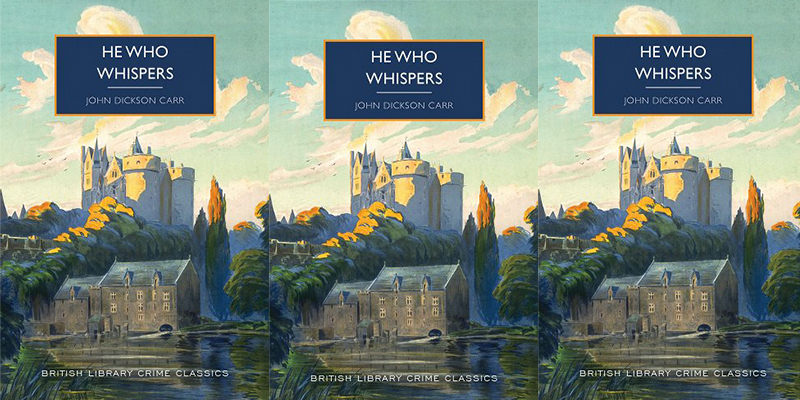A man on his own at the top of an inaccessible tower dies from a stab wound. If he was murdered by human agency, the crime seems quite impossible. Rumours swirl that a vampire killed him. And by strange coincidence—or is it?—there is in the vicinity a mysterious woman whom people believe capable of transforming herself into a bloodsucking creature. This heady blend of murder and the supernatural ensures that He Who Whispers is one of John Dickson Carr’s most popular novels.
The book was first published in 1946 and is set in the previous year, in the immediate aftermath of the long-awaited end of the Second World War. Peace has come to London, but it is clear that things will never be quite the same as they were before the conflict.
The first scene is enticing. We are introduced to Miles Hammond, recently discharged from the army and trying to come to terms with post-war society. Miles is a relatively youthful academic whose distinction is such that in 1938 he won the Nobel Prize in History (Carr wasn’t an author who believed in doing things by halves). He has been invited by Dr. Gideon Fell to attend the first meeting in more than five years of the Murder Club, to be held at Beltring’s Restaurant in Dean Street, Soho. Dr. Fell is secretary of the club, and the guest speaker is to be Professor Rigaud of Edinburgh University.
The Murder Club ‘had become…famous in legend… membership was restricted to thirteen: nine men and four women. The names of its members were celebrated…in law, in literature, in science, in art…[and] they sat far into the night discussing murder cases which had come to be known as classics.’ They ‘revelled in crime; they’ve even hung the picture of a skull on the wall as their symbol.’
Miles arrives late, but finds to his amazement that not only is the Murder Club not already in session, its members are not present at the restaurant. He bumps into a young woman called Barbara Morell, another guest invited by Dr. Fell, and they encounter Professor Rigaud, who is less than overjoyed to have been stood up by his hosts after travelling down from Scotland. Barbara begs the professor to agree that he should give his lecture to Miles and herself, and he agrees.
‘Crime and the occult!’ the professor declares at the outset, with a flourish typical of Carr’s memorable characters. ‘These are the only hobbies for a man of taste!’ He tells the story of a bizarre case which took place in the neighbourhood of Chartres before the war.
He Who Whispers is a cleverly contrived story, and Carr maintains the tension to the very end.A wealthy man called Howard Brooke who lived in a villa just outside the town took on as his secretary the enigmatic but hauntingly attractive Fay Seton. Brooke’s son Harry fell in love with Fay, and they became engaged, to his parents’ displeasure. Standing on the bank of a river close to the villa was the old ruined tower of Henry the Fourth, and on its roof Brooke Senior is found dying.
Rigaud explains that he left Howard Brooke in the best of health on the top of the tower: ‘Following that, the person who murdered him must have visited him on the top of the tower. This person, when his back was turned, must have drawn the sword-cane from its sheath and run him through the body… And this must have occurred between ten minutes to four and five minutes past four, when [he was found dying]… Yet the evidence shows conclusively…that during that time not a living soul came near him.’
The mood of menace is heightened by the fact that ‘sharp teeth-marks in the neck where the life blood had been drained away’ were found on Pierre Fresnac, a young man who lived in the village. Rigaud insists that they were caused by ‘the vampire…the drainer of bodies and killer of souls,’ and he points the finger of suspicion at Fay Seton. Miles cannot believe this, but even Dr. Fell has some sympathy with the professor’s interpretation of events: ‘I do not deny that supernatural forces may exist in this world. In fact, I firmly believe that they do exist.’ Readers familiar with Carr’s work will be aware that at the climax of an earlier novel he had outraged convention by admitting the possibility of a supernatural explanation to a locked room mystery. So we can take nothing for granted.
The plot thickens when Miles meets the woman who has agreed to catalogue his extensive library and discovers (the world of a Golden Age detective story is often a very small one) that she is none other than Fay Seton. He finds himself irresistibly drawn to her, but is uneasily aware that something dreadful happened after she joined the Brooke household. Now she is to become involved not only with him but with his sister Marion and her fiancé Stephen Curtis. When Rigaud and Dr. Fell hear this, Rigaud seems perturbed, and Miles demands to know why he shouldn’t employ Fay. The answer he receives is: ‘Because you and your sister will both die.’
He Who Whispers is a cleverly contrived story, and Carr maintains the tension to the very end. To say much more would risk giving too much away; suffice to say that in this novel he offers puzzles of character as well as of plot.
The Murder Club was a fictional amalgam of various real life institutions. The Detection Club was the world’s first social network of crime writers; Carr was elected to membership in 1936 and subsequently became club secretary. Before the war, the club had premises in Gerrard Street, near Dean Street, and members dined at nearby restaurants. Another important influence, as Douglas G. Greene points out in his biography of Carr, was the Black Maria Club, established in 1939. Members met once at the home of the criminologist F. Tennyson Jesse, but then the war intervened. Carr was no doubt also aware of Our Society, founded in 1903 by people interested in criminology (including Arthur Conan Doyle) and originally known as ‘the Crimes Club.’ Both the Detection Club and Our Society are still going strong today.
When He Who Whispers was first published, the jacket of the American edition emphasized the ‘fair play’ nature of the plot: ‘all the clues are fairly presented to the reader.’ For today’s mystery fans, this novel offers not only an entertaining and atmospheric puzzle with the option of trying to beat Gideon Fell to the solution, but also a fascinating insight into life and social attitudes more than three-quarters of a century ago.
_____________________


















